Fugu, snowboarding & riding camels on sand dunes? Yes, this is Western Japan
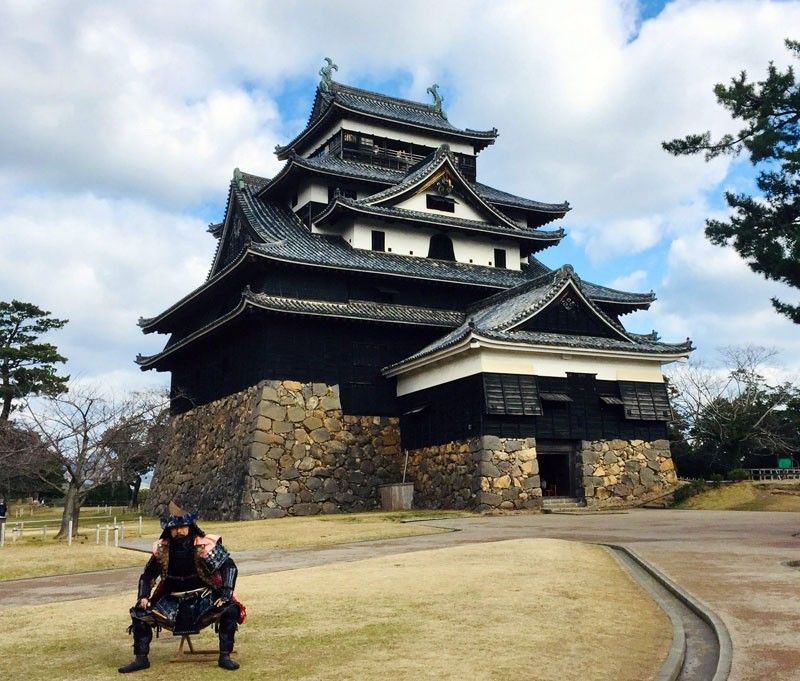
You think you’ve seen Japan? There’s always another side to see. Whether it’s camels carrying tourists along Tottori’s sand dunes facing the Sea of Japan, Instagram-ready deer roaming in front of the O-Torii grand gate of Miyajima Island, or samurais for hire (for events, at least) fronting the world-famous Matsue Castle, Western Japan offers a fresh glimpse of a centuries-old culture that more and more visitors are exploring.
Invited by the Japan National Tourism Organization (JNTO), we did just that: took a journey by bus through four prefectures, starting with Tottori (a place known for its pears, crab, manga studios and 10,000-year-old sand dunes), passing through Shimane and Yamaguchi, and ending up in Hiroshima. Here are some highlights.
Walk a mile for a camel
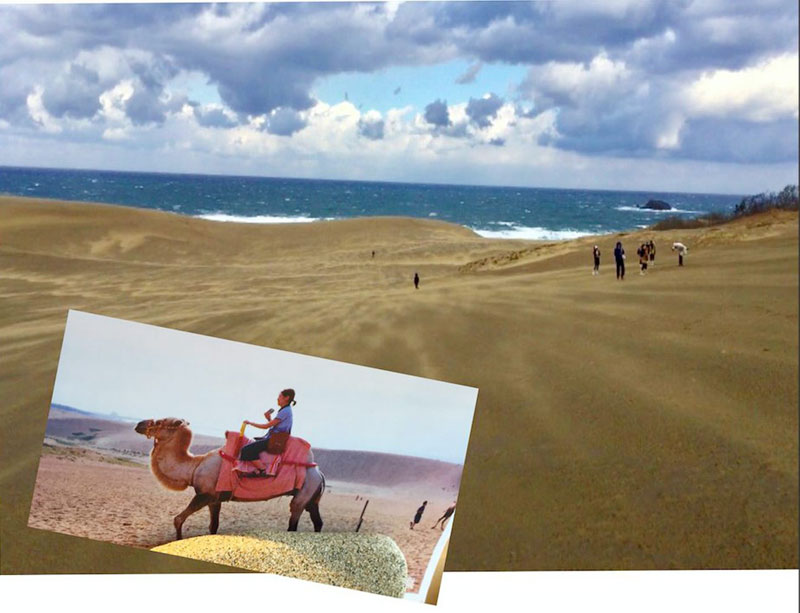
At Tottori Sand Dunes, you can even ride a camel.
Land at Tottori Airport, and the décor is decidedly manga: characters from Japanese TV series Detective Conan greet visitors, and Tottori itself offers Gosho Aoyama Manga Factory, the Mizuku Shigeru Museum and real-life settings from manga artist Taniguchi Jiro’s work. The airport is your portal to Western Japan, accessible from Haneda, Osaka or Kyoto Airport. From there, explore the 16-km stretch of natural Tottori sand dunes that change patterns and shapes as the wind drifts along the coastline. Yes, you can even sandboard, paraglide or rent a camel for a ride (though when we visited on a cold January day, the imported camels were said to be “sleeping.” Perhaps they hibernate in the winter?). It makes a great photo anyway.
Tottori is also known for its pear farms (delicious), Matsuba male snow crabs (a winter favorite) and exotic onsen environments.
Where to eat: Crab burgers and fresh pear juice at Sakyu Center Miharashi-no-Oka near the sand dunes.
Strap on at Mt. Daisen

At Mt. Daisen White Resort in Tottori Prefecture, Japanese are eager skiers and snowboarders.
Snowboarding lessons, awesome ski slopes and excellent fresh powder make Mt. Daisen White Resort (also in Tottori) a great destination for Filipinos wanting to take up winter activities. We hear Hokkaido has gotten so popular among Filipinos seeking a winter wonderland that PAL has added direct flights to Sapporo in the north; Mt. Daisen offers a first-class ski destination to the west, and foreign tourists can get 1,000 yen off the lift ticket price.
At night, we settled in at Kaike Grand Hotel Tensui facing the seacoast. In addition to tatami mat guest rooms, the setting offers a fantastic view of the sea (buffeted by snowy winds that night) and a relaxing onsen experience that actually inspired a haiku on the spot (“Steam melts into air/Comfort of wooden boxes/The soul freed from ice”).
Where to stay: Kaike Onsen, Yonego City, Tottori (www.kaike-grandhotel.co.jp/foreign/tensui/en/)
The frame game
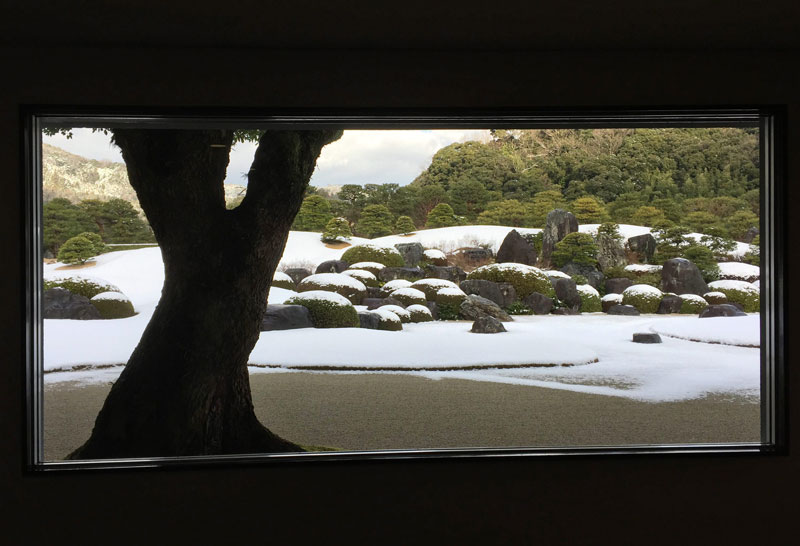
At Adachi Museum of Art in Shimane, enjoy perfect landscapes framed as works of art in any season.
At Adachi Museum of Art in Yasugi, Shimane Prefecture, you not only get to enjoy the private collections of Adachi Zenko, including lyrical painted panels and scrolls by Yokoyama Taikan, Ito Shinsui and (my fave) Hashimoto Kansetsu — you get to gaze upon framed landscaped environments in the gardens surrounding the museum. From inside, look through bay windows, purposely framed as perfect works of art, and take in the outdoor Moss Garden, the Kikaku Waterfall, the Garden of Juryu-An and other highlights. Whether viewed in spring, summer, winter or fall, each season makes Adachi Museum a must-visit destination.
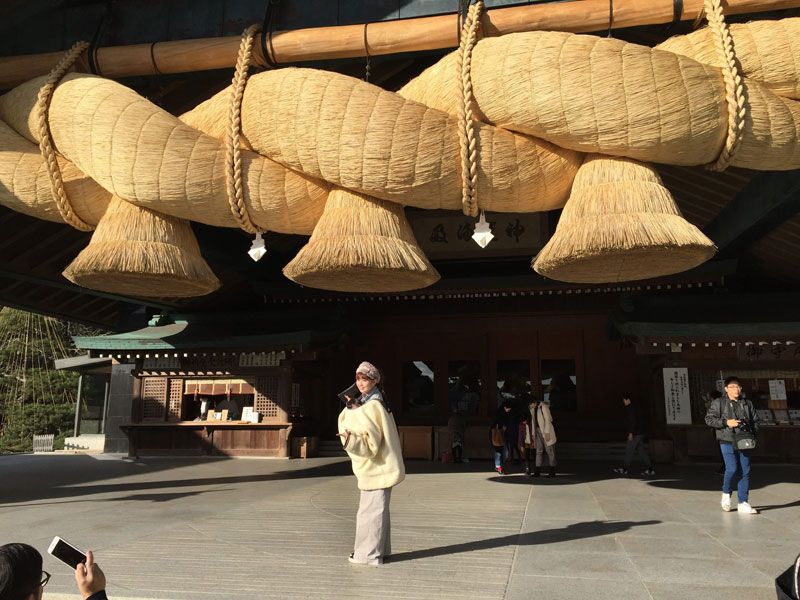
Izumo-Taishi Shrine Izumo in Shimane Prefecture is considered one of most important shrines in Japan.
Shimane does not lack in other aesthetic spots: we also visited Matsue-jo Castle (where we encountered the aforementioned samurai-for-hire) and Izumo-Taisha Shinto Shrine, said to be the ancient “meeting place” of the Shinto gods. Considered a national treasure, its most impressive feature may be the enormous shimenawa rope made of bound, dried rice stalks hanging at the Izumo shrine’s entrance: senior citizens reportedly constructed the rope, and it blesses marriages and bountiful rice crops.
What to do: Make your own Shimenawa Shinto straw festoon at Goenshimenawa craft center in Matsue, Shimane.
Where to eat: Minimikan, a century-old Matsue inn that still serves its special Sea Bream Rice Dish Tai-meshi rice soup.
Gates of heaven

CNN calls the 123 Inari gates of Motonosumi Jinjya Shrine one of Japan’s “Top 31 Sites.”
CNN has called the 123 vermilion-colored torii gates that make up Motonosumi Inari Temple along the road to Nagato in Yamaguchi Prefecture one of the “31 Must-See Sites” of Japan. Built in 1955 by a local fishing business owner who had a vision of a white fox — a divine message to Shinto believers — the row of painted gates is most striking for its backdrop: a spectacular view of the Sea of Japan. Cutesy cartoon foxes adorn the site at various points; a Shinto shrine greets you at the top; and the final gate challenges you to toss a yen coin into a mounted bucket above — if you succeed, your deepest wish may come true.
Cuckoo for Fugu

Shunpanro in Shimonoseki serves a 10-course fugu (blowfish) menu that’s to die for.
Ask anybody what the deadliest food in the world is, and they’ll say fugu, or blowfish. And they wouldn’t be wrong. The puffer or blowfish contains 100 more toxins than cyanide. Prepare it wrong, and you will die — or at least experience tingling of the lips, numbness in the limbs, paralysis, asphyxiation and possibly a coma. Yet fugu is the No. 1 delicacy of Shunpanro restaurant in Shimonoseki, Yamaguchi, known as the “Fugu Capital” of Japan.
It’s said Japan’s first prime minister, It? Hirobumi, visited seaside Shimonoseki in 1888 for a special dinner at Shunpanro. At the time, blowfish had been banned across Japan because its toxic effects had killed a palace official, but a storm in Shimonoseki that day made fishing impossible. The staff scrambled to prepare their leftover fugu in the safest way possible, and PM It? pronounced it… delicious! Since then, the ban has been lifted, but Japan is very careful about licensing fugu chefs: only 22 types of blowfish are allowed for consumption and chefs must pass strict examinations, including how to identify organs and remove any trace of blood.
For our “dare” meal, we tried a 10-course fugu feast that served smoked fugu-tail sake, sashimi, fugu-skin gelatin, Western-style (with butter, garlic, cheese), tofu (with radish), fried (similar to fish and chips, eaten with fingers), hotpot (served steamed), egg custard, salad and a special risotto (almost like congee). Nobody suffered ill effects, and this phenomenal meal is a bargain at about 12,000 yen (about P5,600), though much more expensive in Tokyo). What’s it taste like? Strangely, fugu is rather mild in flavor; its almost transparent taste and texture makes it perfect for a multi-course meal that showcases a chef’s technique.
Where to eat: Shunpanro Shimonoseki Hotel, 4-2 Amidaiji-cho, Shimonoseki-shi, Yamaguchi. (www.shunpanro.com/en/location/shimonoseki/stay.html)
Eat, pray, cave, bridge
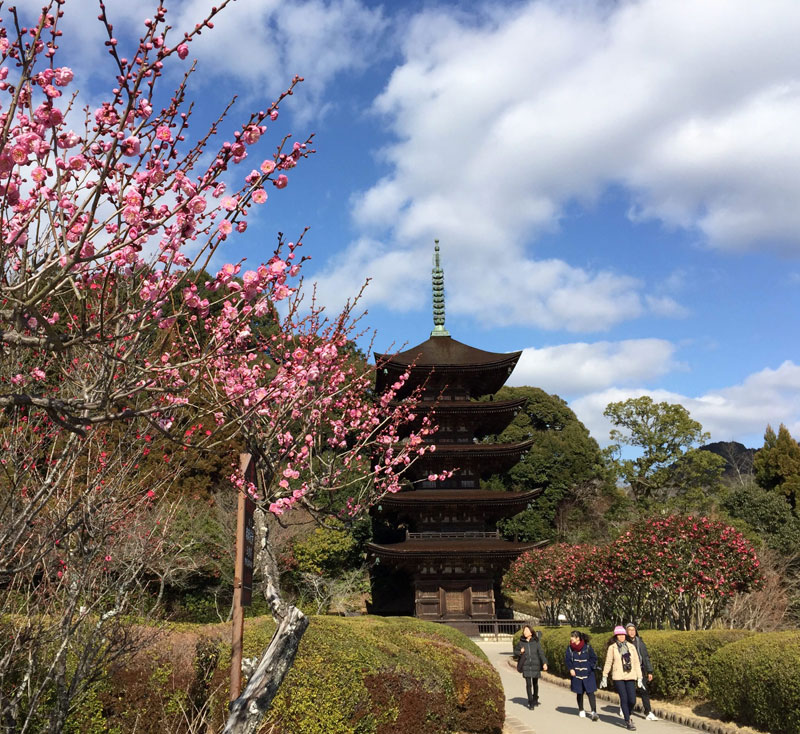
The Rurikoji five-story pagoda temple in Yamaguchi
Above the Akiyoshido Caves in Yamaguchi, you see limestone jutting out from the ground at odd angles; 83 meters below, you can explore well-lit limestone caverns with interesting shapes going back millions of years; English recordings along the way explain what you’re seeing, such as the One Hundred Plates field of limestone pools (similar to our Banaue rice terraces) and a huge stalagmite pile that does indeed resemble Mt. Fuji.
Later, a ride along the coast takes you to Tsunoshima Bridge. Constructed in 2000, it’s a popular movie location and the largest bridge in Japan, with a spectacular viewpoint showing off its 1,780-meter span.
Also in Yamaguchi is the Rurikoji five-story pagoda temple built round 1442, considered one of Japan’s three greatest wooden pagodas (originally storehouses for relics, such as the Buddha’s ashes). Take a stroll through the nearby Kozan Park, and at the base of the splendid Buddhist temple to the right, you’ll notice a burial site for members of the Mori family, who ruled the region during the Edo Period (1603-1867).
Where to eat: Hareruya, a café inn rebuilt from a former rice farm, offers a great view of Tsunoshima Bridge.
Hiroshima’s legacy of peace
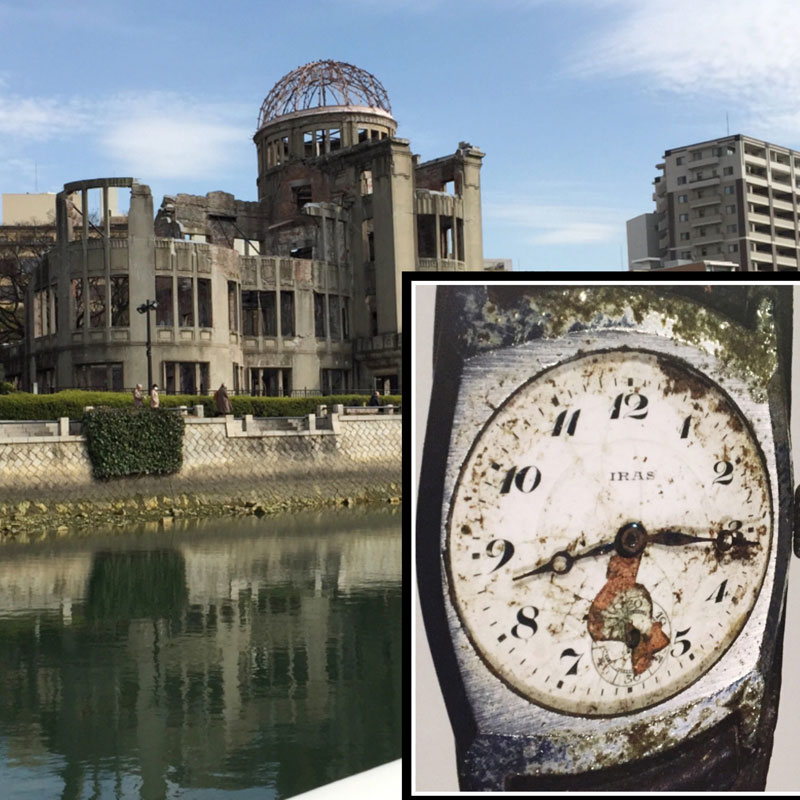
Time’s up: Hiroshima lived through the Aug. 6, 1945 atomic blast.
At 8:15 a.m., on Aug. 6, 1945, the United States dropped the world’s first atomic bomb on Hiroshima, killing 70,000 people instantly. Temperatures near the blast zone reached 4,000 degrees Celsius; skin melted off; another 70,000 succumbed to burns and radiation sickness soon after; burn victims sought relief by jumping in the nearby river, but its waters were also boiling.
In present-day Hiroshima, the closest reminder of that hour is the Atomic Bomb Dome monument, a former government office near the hypocenter of the blast, its twisted shell a memento of a force beyond anything man had ever seen. Our tour guide Yuko Ehara pointed out a nearby street tram (still operating) that was key to delivering food and medical supplies to the city days after it was reduced to rubble. Do they also keep the tram running as a reminder, I ask? Maybe, she says, but also, “it’s unthinkable to build a subway here because only a few meters down, you would come across human remains.”
It was fate — and bad weather elsewhere — that led the US to target Hiroshima for bombing. Ehara doesn’t blame the US, exactly (“We are taught that war is bad; people are not bad”); and Hiroshima has somehow managed to find meaning in the most mind-wrenching horror imaginable. At the Hiroshima Peace Memorial Museum the next day, we get up-close glimpses of that horror: dresses and school uniforms shredded by the blast; a tricycle that was almost liquefied by the explosion (the child riding it died of burns that day); a man’s wristwatch, stopped forever at 8:15 a.m.
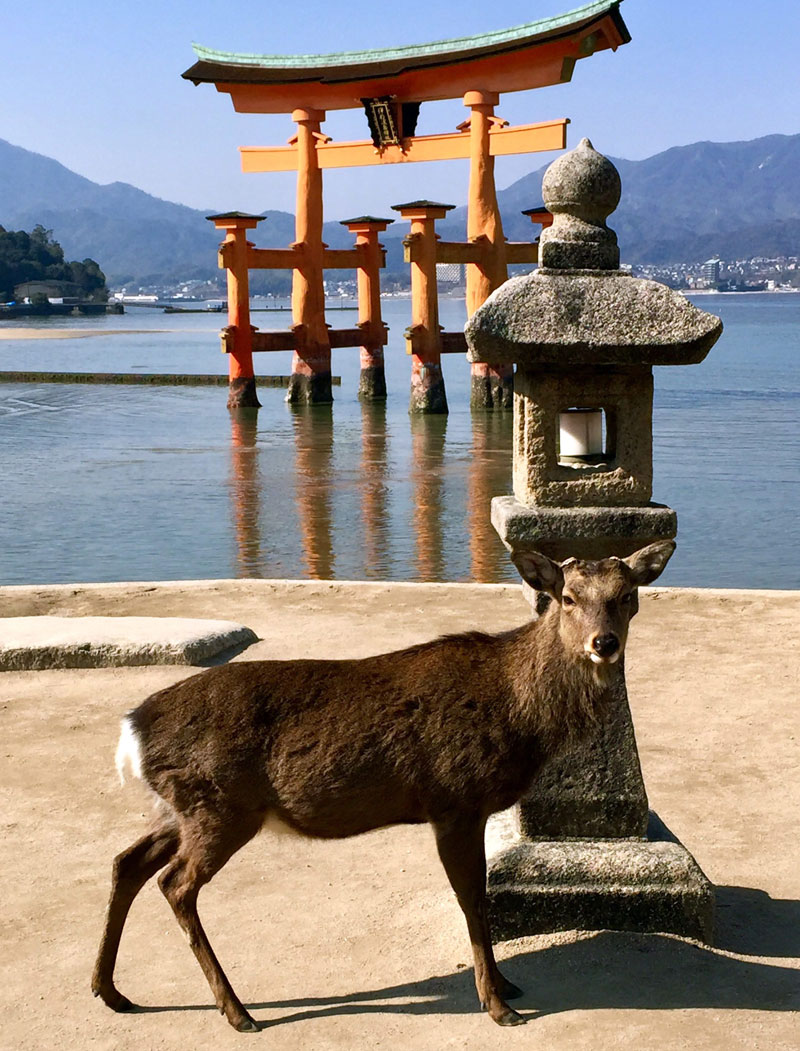
A deer gamely poses before O-Torii Grand Gate on Miyajima Island.
But there’s also a message of rebuilding and hope: the people of Hiroshima became anti-war activists; during the ’80s, survivors of Hiroshima protested loudly against all governments testing nuclear weapons. When US President Obama visited Hiroshima in 2016, some Americans thought it unpatriotic to “apologize” for US actions. Our JNTO guide Masura Ikeda has a different outlook: Obama, he says, paid a visit “from his heart.” No politics involved.
Two other touching sites are the Orizuru Tower and Children’s Peace Monument, both memorializing Sadako Sasaki, age two during the WWII blast, who survived to become an athlete — until leukemia from her radiation exposure confined her to a hospital. There, she took up the Japanese legend of folding a thousand paper origami cranes (orizuru) in order to have your wish (for health) granted. Did she reach 1,000 before she died? Facts are unclear, but thousands of kids continued folding cranes and the Orizuru Tower allows children today to remember her wish by folding their own cranes; nearby, the Children’s Peace Monument showcases thousands of colorful orizuru donated by schools around the country.
The day before that, we took a ferry ride to Miyajima Island, considered one of Japan’s top three scenic spots. The grand O-Torii gate set in its bay is approachable at low tide; take the majestic Ropeway cable car 430 meters to the top of Mt. Misen for a glimpse of Hiroshima bay, then head back down to the island, stroll through Itsukushima Shrine and mingle with the wild deer cavorting amid Shinto monuments. No wonder this island was off-limits to humans until the 6th century: it was considered the home of the gods.
Where to eat: Otafuku offers a unique make-your-own okonomiyaki dining experience in downtown Hiroshima. Great fun for groups! (www.otafuku.co.jp)
Where to stay: Grand Prince Hotel offers modern rooms, onsen, and spectacular views of Hiroshima city from the 23rd floor. (www.princehotels.co.jp)
* * *
For more information on Western Japan destinations, visit www.japan.travel/en/destinations/. Follow #JNTO on Instagram.
Okayama Station, on the JR Tokaido-Sanyo Shinkansen Line, is the main transport hub for access to Shimane. From there, express trains operate and stop at Yasugi, Matsue and Izumo-shi stations in the north.



















